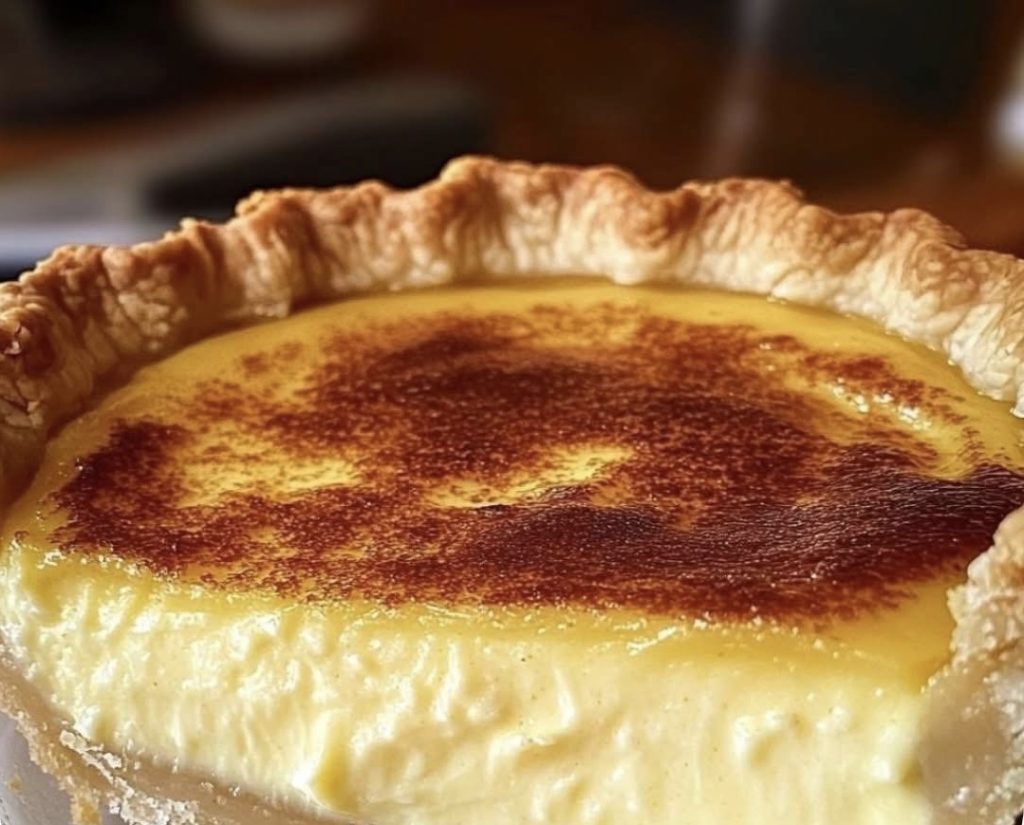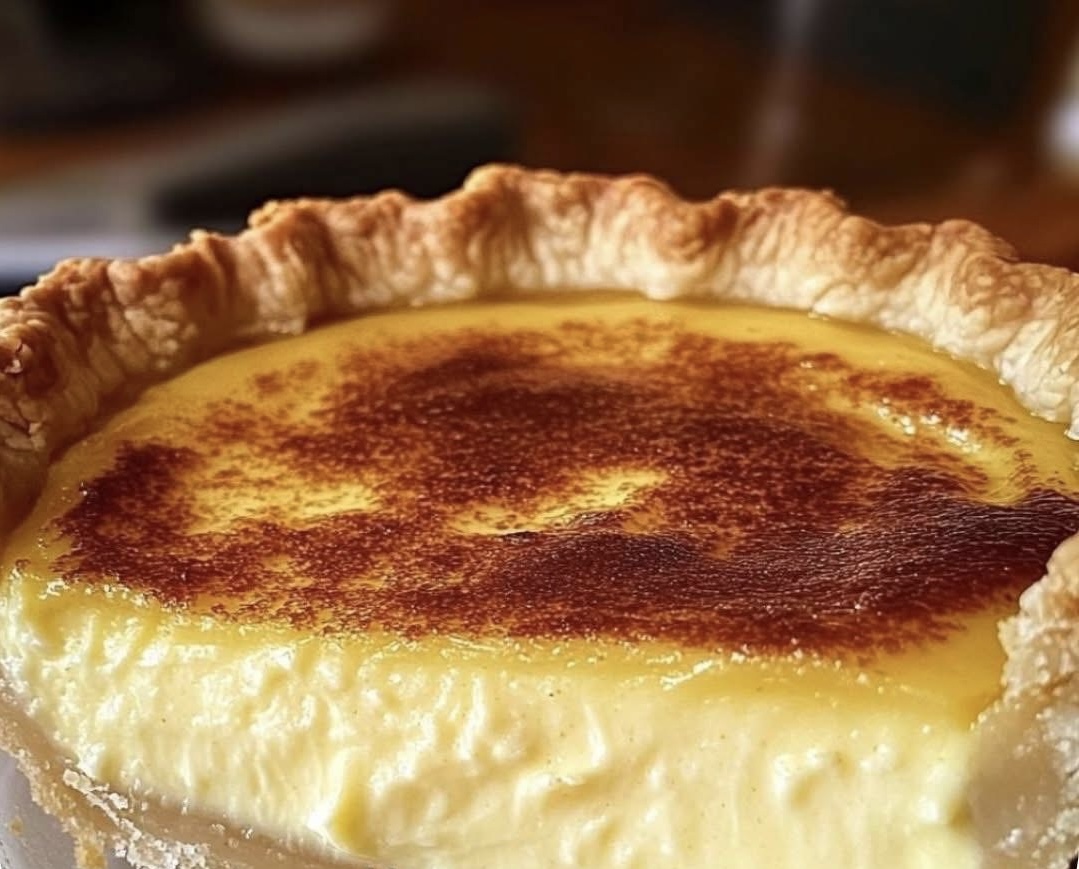Old-Fashioned Custard Pie

Introduction
Old-Fashioned Custard Pie is a classic dessert that evokes a sense of nostalgia with its creamy, delicate texture and rich flavor. Originating from traditional European cuisine, custard pie became a beloved treat in American households, often served during holidays or family gatherings. Its simplicity and elegance make it a timeless favorite.
Ingredients
For the Pie Crust:
- 1 deep-dish unbaked pie shell (e.g., Marie Callender’s or homemade)
For the Custard Filling:
- 3 large eggs
- 1 cup granulated sugar
- 2 cups whole milk
- 1 teaspoon vanilla extract
- 1/4 teaspoon ground nutmeg
- A pinch of salt
Instructions
Step 1: Preheat the Oven
- Preheat your oven to 400°F (200°C). Place the oven rack in the center for even baking.
Step 2: Prepare the Pie Shell
- If using a store-bought pie shell, ensure it is thawed. Place it on a baking sheet for stability.
Step 3: Make the Custard Filling
- In a large mixing bowl, whisk the eggs until frothy.
- Gradually add sugar, continuing to whisk until fully combined.
- Slowly incorporate the milk, vanilla extract, salt, and nutmeg. Mix until smooth and consistent.
Step 4: Assemble the Pie
- Carefully pour the custard mixture into the unbaked pie shell. To avoid spills, transfer the shell to the oven first, then pour the filling.
Step 5: Bake
- Bake for 10 minutes at 400°F. Then, reduce the oven temperature to 350°F (175°C) and continue baking for 30–40 minutes, or until the custard is set but slightly jiggly in the center.
Step 6: Cool and Serve
- Remove from the oven and let the pie cool at room temperature. For best results, refrigerate for 1–2 hours before serving.
History
Custard pie has its roots in medieval Europe, where egg-based dishes were common. The combination of milk, sugar, and eggs became a symbol of wealth and hospitality. Over time, variations of the recipe spread across the world, with each culture adding its unique twist. In America, the pie is cherished as part of the Southern comfort food tradition.
Custard pie has a rich and fascinating history, tracing its roots back to medieval Europe, where custard-based desserts first gained popularity. The word “custard” comes from the French term croustade, referring to a crusted pastry. Custard pies were initially prepared in royal kitchens and for special feasts, as eggs, milk, and sugar were considered luxurious ingredients.
Medieval Origins
Custards appeared in early European cookbooks as a blend of eggs and milk thickened with gentle heat. In these times, pies were more savory than sweet, often including meats or spices. By the 14th century, recipes for sweet custard pies emerged, becoming a staple in English kitchens.
Colonial Adaptation
Custard pie crossed the Atlantic with European settlers and became a cherished dessert in America. Early colonial recipes were simple, relying on fresh farm eggs, milk, and pantry staples like nutmeg or cinnamon for flavor. These ingredients were readily available, making the pie a practical dessert for home cooks.
Cultural Significance
Custard pie became a hallmark of Southern American cuisine. Known for its simplicity and versatility, it was served at family gatherings, church picnics, and holiday meals. The addition of spices like nutmeg or vanilla became a signature touch, and the pie gained its reputation as a comfort food staple.
Modern Era
Today, custard pie remains a classic dessert, with variations found in cultures worldwide. From French flan to Portuguese pastéis de nata, the concept of a creamy, egg-based filling encased in a crust has stood the test of time. The American version is cherished for its old-fashioned charm and nostalgic appeal.
Custard pie’s enduring popularity lies in its simplicity, versatility, and timeless flavor, making it a beloved dessert for generations.
Benefits
- Nutritional Value: Custard pie provides a good source of protein, calcium, and essential vitamins like B12 from the eggs and milk.
- Versatility: Can be customized with spices like cinnamon or cardamom for varied flavors.
- Digestibility: The creamy texture makes it easy to digest, making it suitable for all age groups.
Here are the benefits of Old-Fashioned Custard Pie:
1. Rich in Nutrients
- The main ingredients—milk and eggs—provide essential nutrients such as protein, calcium, and vitamins (like B12 and D). These are vital for strong bones, teeth, and muscle repair.
2. Energy Boost
- With its balance of carbohydrates, fats, and proteins, custard pie provides a quick energy source, making it an excellent dessert to keep you energized.
3. Good for Digestion
- The creamy texture makes custard pie easy to digest, making it suitable for people of all ages, including kids and the elderly.
4. Comfort Food
- Custard pie offers emotional benefits as well. Its nostalgic taste can evoke memories of family gatherings and bring a sense of comfort and joy.
5. Versatile Dessert
- The pie can be adapted to suit dietary needs—using lactose-free milk or a gluten-free crust ensures more people can enjoy it.
6. Promotes Bone Health
- The calcium and phosphorus in milk contribute to bone density and strength, reducing the risk of osteoporosis.
7. Customizable for Additional Benefits
- Adding ingredients like cinnamon or nutmeg enhances antioxidant properties. You can also include fresh fruits for added fiber and vitamins.
Custard pie is a great combination of indulgence and nourishment, making it a treat with surprising benefits!
Formation
- The custard is formed when the proteins in the eggs coagulate during baking, giving the pie its firm yet creamy consistency. The nutmeg adds an aromatic finish, complementing the smooth texture.
Nutritional Information (Per Slice)
- Calories: 280
- Protein: 6g
- Carbohydrates: 32g
- Fat: 14g
- Fiber: 0g
- Calcium: 100mg
- Sugars: 22g
Here is the approximate nutritional information per slice (assuming an 8-slice pie):
- Calories: 280
- Protein: 6g
- Total Fat: 14g
- Saturated Fat: 7g
- Trans Fat: 0g
- Cholesterol: 120mg
- Carbohydrates: 32g
- Dietary Fiber: 0g
- Sugars: 22g
- Sodium: 160mg
- Calcium: 100mg
- Iron: 1mg
- Vitamin D: 1.2mcg
Key Highlights:
- Protein Source: Eggs and milk provide a good amount of protein, supporting muscle repair and growth.
- Calcium-Rich: The milk contributes to calcium intake, promoting strong bones and teeth.
- Energy-Dense: The combination of fats and carbohydrates makes it a good source of quick energy.
While custard pie is indulgent, it provides a nice balance of nutrients, especially when consumed in moderation. For a healthier option, you can reduce sugar or use low-fat milk.
Conclusion
Old-Fashioned Custard Pie is more than just a dessert; it’s a piece of culinary history passed down through generations. Whether served warm or chilled, its timeless appeal lies in its simplicity and rich flavor.
Lovers of Custard Pie
Custard pie is a favorite among those who appreciate traditional, homemade desserts. It appeals to people who enjoy creamy, lightly sweetened dishes and has a loyal following among fans of classic Southern and European pastries.
